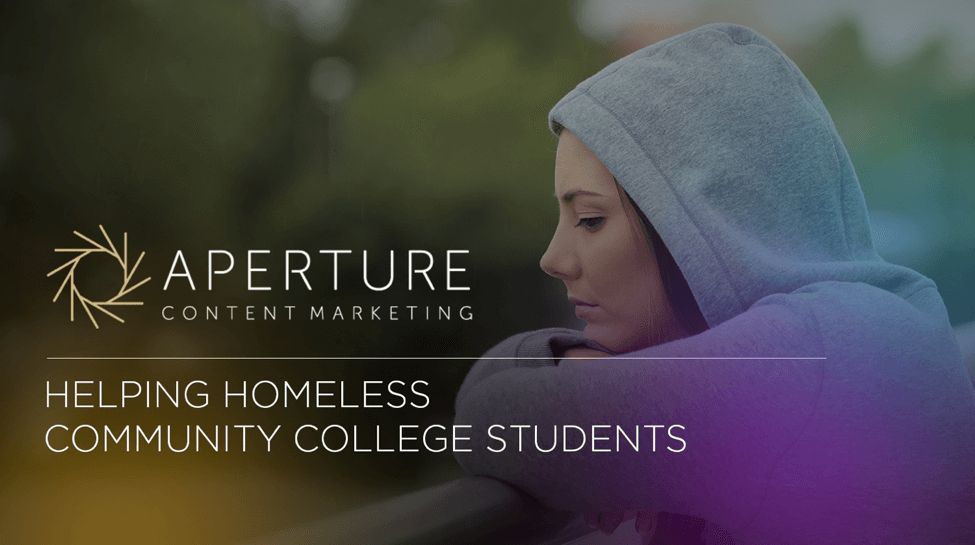Housing insecurity affects half of community college students.
A new study by the Hope Center for College, Community, and Justice (Hope Center) reveals that a large number of college students are either homeless or food insecure. Despite the relatively low cost of tuition at community colleges, community college students are more likely than other students to be housing or food insecure during their time at college.
For those familiar with the student demographic at community colleges, it’s clear why that might be the case. Statistics show that community colleges students are more likely than students at private or public schools to come from extremely low-income families, and so lack the social safety nets that could prevent homelessness and hunger.
Hunger and housing insecurity devastate persistence and retention rates
The consequences of food and housing insecurity are dire, both for students and institutions of higher education. The report states:
Food and housing insecurity undermine academic success. Housing insecurity and homelessness have a particularly strong, statistically significant relationship with college completion rates, persistence, and credit attainment. Researchers also associate basic needs insecurity with self-reports of poor physical health, symptoms of depression, and higher perceived stress.
It’s clear that solving problems of persistence and completion at community colleges will require addressing the issues of housing and food security. So how can community colleges address these intractable issues?
Don’t let students leave money on the table
It’s alarming how many students fail to fill out the FAFSA, and so miss out on state and federal aid. In fact, the high school class of 2018 missed out on 2.6 billion dollars of federal aid, simply because more than half a million of them failed to complete the FAFSA. These students would have qualified for Pell grants, had they turned in the requisite paperwork.
On average, these students could have received nearly $4,000 apiece, a significant sum especially for college-bound students from low-income families. One thing that community colleges can do to encourage FAFSA filing is to make sure students know about all the available tools for filing. A new FAFSA app makes it easier than ever to get the work done.
Help students find resources that they need
Many low-income community college students qualify for additional benefits. However, despite the fact that nearly half of college students report food insecurity, 1.8 million low-income students who could probably qualify for the federal Supplemental Nutrition Assistance Program (SNAP), are not using the resource.
One barrier could be that students are embarrassed to seek out help on their own. Community colleges can make difference. Appropriately counseling students who might be eligible for such programs, and referring them to the right agencies, or even helping them file applications for aid, could reduce food insecurity on campus.
Offering on-campus aid programs for college students
Some campuses are taking further steps to assist college students, apart from referring them to state agencies. Last year Gov. Andrew Cuomo announced that all New York State public colleges at the State University of New York and the City University of New York will have on-campus food pantries.
Launching the initiative, Cuomo said “Hunger should never be a barrier for those seeking to achieve their dreams of a higher education.” The new food pantries will give tangible meaning to those promises, as they have at other community colleges.
What does the Hope Center recommend?
The authors of the basic needs security survey made some specific recommendations for alleviating food and housing insecurity among undergraduate students:
- Appoint a director of student wellness and basic needs who can coordinate institutional responses to food and housing insecurity.
- Create a ‘culture of caring’ among faculty and staff rather establishing a lone office to address basic needs.
- Proactively partner with community organizations, rather than reacting to immediate crises
- Create an emergency aid program offering immediate cash assistance.
- Lobby for smarter government responses to housing and food insecurity among students, who may work less than 20 hours a week or only attend school part-time, and so fail to qualify for public assistance.
Few of these recommendations can be enacted immediately. Still, all could measurably decrease hunger and homelessness among students. This in turn could improve student outcomes, smoothing the path to completion.
Let students know that they aren’t alone
Community colleges cannot single-handedly alleviate the problems of poverty. However, at least this new research lets us register the scope of the issues on our campuses. With solid numbers we become better advocates for needy students.
For now, schools can be vocal about available assistance. Students should see visible reminders on campus that their situation isn’t unique, and that the school can help. Your college can mobilize the college’s social media accounts, listserv, and campus display spaces to call attention to any campus resources.
This new research could also become a valuable feature piece in your school’s CareerFocus publication. Sometimes all a student needs to know is that they aren’t alone – that others have faced the same odds and succeeded.
Still wondering if your school can do more?
Visit the Hope Center’s website, for more resources and ideas, as well as information on its annual conference. On the site you will find valuable guides for faculty and staff, student-to-student publications, and policy toolkits.


